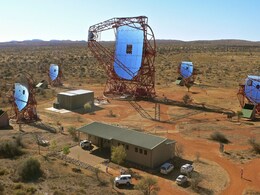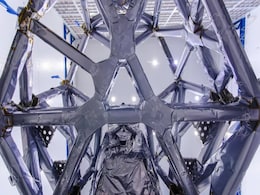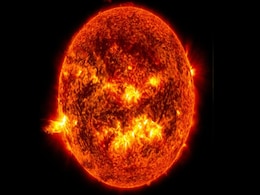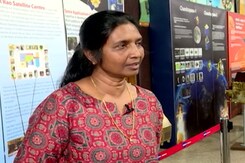Solar Observatory
- All
- News
- Videos
-

Comet ATLAS Offers Stunning Display as It Nears the Sun
- Friday January 24, 2025
- Written by Gadgets 360 Staff
Comet C/2024 G3 (ATLAS) recently passed within 8 million miles of the Sun, capturing the attention of astronomers. Observed by NASA and ESA’s Solar and Heliospheric Observatory (SOHO), the comet’s tail extended dramatically as it encountered intense solar winds, providing a unique opportunity to study the Sun’s impact on comets. The event, wh...
-
 www.gadgets360.com
www.gadgets360.com
-

Study Finds Coronal Loop Flickers Could Predict Solar Flares Hours in Advance
- Friday January 17, 2025
- Written by Gadgets 360 Staff
NASA's Solar Dynamics Observatory has revealed a potential breakthrough in predicting solar flares. Scientists observed brightness fluctuations in coronal loops—plasma structures in the Sun's atmosphere—that intensify hours before solar flares occur. This discovery, with a prediction accuracy of 60–80%, may provide 2–6 hours of advance warn...
-
 www.gadgets360.com
www.gadgets360.com
-

NASA's Solar Observatories Resume Data Operations After Flood Disruption
- Monday January 13, 2025
- Written by Gadgets 360 Staff
NASA’s Solar Dynamics Observatory (SDO) and Interface Region Imaging Spectrograph (IRIS) have resumed data operations following a flood at Stanford University on November 26, 2024. The incident damaged systems at the Joint Science Operations Center (JSOC), impacting access to critical solar data. Despite challenges, partial database restoration h...
-
 www.gadgets360.com
www.gadgets360.com
-

Rubin Observatory’s 2025 Debut Could Unveil Hidden Dark Comets in Space
- Thursday January 9, 2025
- Written by Gadgets 360 Staff
The Vera Rubin Observatory, set to begin operations in 2025, is expected to revolutionise the study of dark comets. These elusive objects, which lack visible tails but exhibit non-gravitational acceleration, have already been identified in our solar system, but their true numbers remain unknown. The observatory's advanced technology, including a po...
-
 www.gadgets360.com
www.gadgets360.com
-

Scientists Develop New Approach to Capture Gravitational Wave Memory from Supernovae
- Wednesday December 18, 2024
- Written by Gadgets 360 Staff
A study published in Physical Review Letters highlights new methods to detect the gravitational wave memory effect, a unique phenomenon predicted by Einstein's general relativity. Core-collapse supernovae (massive stellar explosions) generate these low-frequency gravitational waves, offering a rare glimpse into stellar interiors. Despite their weak...
-
 www.gadgets360.com
www.gadgets360.com
-

Namibian Observatory Spots Highest Energy Cosmic Electrons Opening Better Understanding of Cosmic Rays
- Tuesday November 26, 2024
- Written by Gadgets 360 Staff
The H.E.S.S. Observatory in Namibia has detected the highest-energy cosmic ray electrons ever observed, suggesting sources within a few hundred light-years. The findings point to extreme phenomena like pulsars and supernova remnants, offering insights into cosmic processes and particle accelerators. The breakthrough provides crucial data for future...
-
 www.gadgets360.com
www.gadgets360.com
-

NASA Supercomputers Help Unravel Complex Movements of the Sun’s Inner Layers
- Monday November 25, 2024
- Written by Gadgets 360 Staff
NASA supercomputers have provided a detailed look into the Sun’s complex inner workings by simulating its plasma flows. Using data from various space missions, including the Solar Dynamics Observatory, researchers have recreated turbulent motions and shock waves within the Sun’s layers. These insights will enhance space weather predictions, whi...
-
 www.gadgets360.com
www.gadgets360.com
-

NASA Showcases AI-Powered Computational Tools to Advance Scientific Research at SC24 Event
- Wednesday November 20, 2024
- Written by Gadgets 360 Staff
At SC2024, NASA’s Nicola Fox revealed the agency’s new AI-powered computational tools aimed at improving space science. These tools will be deployed across divisions, including Earth science, heliophysics, and astrophysics. A key example presented was a heliophysics model using data from the Solar Dynamics Observatory to predict solar wind and ...
-
 www.gadgets360.com
www.gadgets360.com
-

NASA's Roman Space Telescope Gets New Coronagraph to Spot Exoplanets
- Tuesday November 12, 2024
- Written by Gadgets 360 Staff
NASA's Roman Space Telescope has successfully integrated the Roman Coronagraph, a vital step in detecting planets far beyond our solar system. This tool will help block starlight, enabling the telescope to capture faint planetary light. The coronagraph marks a significant advancement in exoplanet detection, allowing the telescope to observe planets...
-
 www.gadgets360.com
www.gadgets360.com
-

NASA Might Have Spotted Highest Number of Sunspots in Over 20 Years
- Tuesday August 20, 2024
- Gadgets 360 Staff
On August 8, 2024, NASA's Solar Dynamics Observatory (SDO) may have documented a record-breaking number of sunspots in a single day, marking a significant event in Solar Cycle 25. These sunspots, which are dark, cooler areas on the Sun’s surface caused by intense magnetic activity, play a crucial role in the Sun's behaviour and have a direct impa...
-
 www.gadgets360.com
www.gadgets360.com
-

India's Solar Observatory Aditya-L1 Completes Halo Orbit: ISRO
- Wednesday July 3, 2024
- India News | Indo-Asian News Service
Aditya-L1 spacecraft, known as India's solar observatory, has completed its first halo orbit around the Sun-Earth Lagrange Point 1 (L1), announced mission officials at the Indian Space Research Organisation (ISRO).
-
 www.ndtv.com
www.ndtv.com
-

Solar System May Soon Have A Ninth Planet. Courtesy: An Advanced Telescope
- Monday June 24, 2024
- World News | Edited by NDTV News Desk
As per NASA, the composition of Planet X is like Neptune, but its mass could be 10 times that of Earth.
-
 www.ndtv.com
www.ndtv.com
-

Sun's Fury May Fry Satellites, But India Has A Watchful Space Protector
- Monday June 10, 2024
- Science | Written by Pallava Bagla
India's maiden space-based solar observatory, Aditya L1 satellite, has recently captured 'solar fury' and now the Indian Space Research Organisation (ISRO) has warned that the Sun is moving towards "its solar maximum, giving rise to enhanced activity
-
 www.ndtv.com
www.ndtv.com
-

Total Solar Eclipse Today: Why India's Sun Satellite Won't Catch A Glimpse
- Monday April 8, 2024
- India News | Reported by Pallava Bagla, Edited by Abhimanyu Kulkarni
India's first space-based solar observatory, Aditya L1, is continuously studying the Sun but will miss the total solar eclipse today that will be visible over vast swaths of North America.
-
 www.ndtv.com
www.ndtv.com
-

ISRO's Aditya- L1 Satellite Has A Date With The Sun
- Saturday January 6, 2024
- India News | Written by Pallava Bagla
India's "celestial surya namaskar" is about to reach its climax. India's first space-based solar observatory -- the Aditya-L1 satellite -- is going to check-in to the home it is likely to occupy for the next five years.
-
 www.ndtv.com
www.ndtv.com
-

Comet ATLAS Offers Stunning Display as It Nears the Sun
- Friday January 24, 2025
- Written by Gadgets 360 Staff
Comet C/2024 G3 (ATLAS) recently passed within 8 million miles of the Sun, capturing the attention of astronomers. Observed by NASA and ESA’s Solar and Heliospheric Observatory (SOHO), the comet’s tail extended dramatically as it encountered intense solar winds, providing a unique opportunity to study the Sun’s impact on comets. The event, wh...
-
 www.gadgets360.com
www.gadgets360.com
-

Study Finds Coronal Loop Flickers Could Predict Solar Flares Hours in Advance
- Friday January 17, 2025
- Written by Gadgets 360 Staff
NASA's Solar Dynamics Observatory has revealed a potential breakthrough in predicting solar flares. Scientists observed brightness fluctuations in coronal loops—plasma structures in the Sun's atmosphere—that intensify hours before solar flares occur. This discovery, with a prediction accuracy of 60–80%, may provide 2–6 hours of advance warn...
-
 www.gadgets360.com
www.gadgets360.com
-

NASA's Solar Observatories Resume Data Operations After Flood Disruption
- Monday January 13, 2025
- Written by Gadgets 360 Staff
NASA’s Solar Dynamics Observatory (SDO) and Interface Region Imaging Spectrograph (IRIS) have resumed data operations following a flood at Stanford University on November 26, 2024. The incident damaged systems at the Joint Science Operations Center (JSOC), impacting access to critical solar data. Despite challenges, partial database restoration h...
-
 www.gadgets360.com
www.gadgets360.com
-

Rubin Observatory’s 2025 Debut Could Unveil Hidden Dark Comets in Space
- Thursday January 9, 2025
- Written by Gadgets 360 Staff
The Vera Rubin Observatory, set to begin operations in 2025, is expected to revolutionise the study of dark comets. These elusive objects, which lack visible tails but exhibit non-gravitational acceleration, have already been identified in our solar system, but their true numbers remain unknown. The observatory's advanced technology, including a po...
-
 www.gadgets360.com
www.gadgets360.com
-

Scientists Develop New Approach to Capture Gravitational Wave Memory from Supernovae
- Wednesday December 18, 2024
- Written by Gadgets 360 Staff
A study published in Physical Review Letters highlights new methods to detect the gravitational wave memory effect, a unique phenomenon predicted by Einstein's general relativity. Core-collapse supernovae (massive stellar explosions) generate these low-frequency gravitational waves, offering a rare glimpse into stellar interiors. Despite their weak...
-
 www.gadgets360.com
www.gadgets360.com
-

Namibian Observatory Spots Highest Energy Cosmic Electrons Opening Better Understanding of Cosmic Rays
- Tuesday November 26, 2024
- Written by Gadgets 360 Staff
The H.E.S.S. Observatory in Namibia has detected the highest-energy cosmic ray electrons ever observed, suggesting sources within a few hundred light-years. The findings point to extreme phenomena like pulsars and supernova remnants, offering insights into cosmic processes and particle accelerators. The breakthrough provides crucial data for future...
-
 www.gadgets360.com
www.gadgets360.com
-

NASA Supercomputers Help Unravel Complex Movements of the Sun’s Inner Layers
- Monday November 25, 2024
- Written by Gadgets 360 Staff
NASA supercomputers have provided a detailed look into the Sun’s complex inner workings by simulating its plasma flows. Using data from various space missions, including the Solar Dynamics Observatory, researchers have recreated turbulent motions and shock waves within the Sun’s layers. These insights will enhance space weather predictions, whi...
-
 www.gadgets360.com
www.gadgets360.com
-

NASA Showcases AI-Powered Computational Tools to Advance Scientific Research at SC24 Event
- Wednesday November 20, 2024
- Written by Gadgets 360 Staff
At SC2024, NASA’s Nicola Fox revealed the agency’s new AI-powered computational tools aimed at improving space science. These tools will be deployed across divisions, including Earth science, heliophysics, and astrophysics. A key example presented was a heliophysics model using data from the Solar Dynamics Observatory to predict solar wind and ...
-
 www.gadgets360.com
www.gadgets360.com
-

NASA's Roman Space Telescope Gets New Coronagraph to Spot Exoplanets
- Tuesday November 12, 2024
- Written by Gadgets 360 Staff
NASA's Roman Space Telescope has successfully integrated the Roman Coronagraph, a vital step in detecting planets far beyond our solar system. This tool will help block starlight, enabling the telescope to capture faint planetary light. The coronagraph marks a significant advancement in exoplanet detection, allowing the telescope to observe planets...
-
 www.gadgets360.com
www.gadgets360.com
-

NASA Might Have Spotted Highest Number of Sunspots in Over 20 Years
- Tuesday August 20, 2024
- Gadgets 360 Staff
On August 8, 2024, NASA's Solar Dynamics Observatory (SDO) may have documented a record-breaking number of sunspots in a single day, marking a significant event in Solar Cycle 25. These sunspots, which are dark, cooler areas on the Sun’s surface caused by intense magnetic activity, play a crucial role in the Sun's behaviour and have a direct impa...
-
 www.gadgets360.com
www.gadgets360.com
-

India's Solar Observatory Aditya-L1 Completes Halo Orbit: ISRO
- Wednesday July 3, 2024
- India News | Indo-Asian News Service
Aditya-L1 spacecraft, known as India's solar observatory, has completed its first halo orbit around the Sun-Earth Lagrange Point 1 (L1), announced mission officials at the Indian Space Research Organisation (ISRO).
-
 www.ndtv.com
www.ndtv.com
-

Solar System May Soon Have A Ninth Planet. Courtesy: An Advanced Telescope
- Monday June 24, 2024
- World News | Edited by NDTV News Desk
As per NASA, the composition of Planet X is like Neptune, but its mass could be 10 times that of Earth.
-
 www.ndtv.com
www.ndtv.com
-

Sun's Fury May Fry Satellites, But India Has A Watchful Space Protector
- Monday June 10, 2024
- Science | Written by Pallava Bagla
India's maiden space-based solar observatory, Aditya L1 satellite, has recently captured 'solar fury' and now the Indian Space Research Organisation (ISRO) has warned that the Sun is moving towards "its solar maximum, giving rise to enhanced activity
-
 www.ndtv.com
www.ndtv.com
-

Total Solar Eclipse Today: Why India's Sun Satellite Won't Catch A Glimpse
- Monday April 8, 2024
- India News | Reported by Pallava Bagla, Edited by Abhimanyu Kulkarni
India's first space-based solar observatory, Aditya L1, is continuously studying the Sun but will miss the total solar eclipse today that will be visible over vast swaths of North America.
-
 www.ndtv.com
www.ndtv.com
-

ISRO's Aditya- L1 Satellite Has A Date With The Sun
- Saturday January 6, 2024
- India News | Written by Pallava Bagla
India's "celestial surya namaskar" is about to reach its climax. India's first space-based solar observatory -- the Aditya-L1 satellite -- is going to check-in to the home it is likely to occupy for the next five years.
-
 www.ndtv.com
www.ndtv.com























